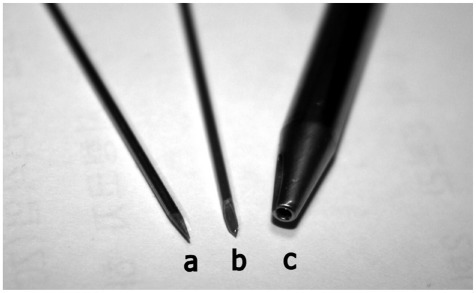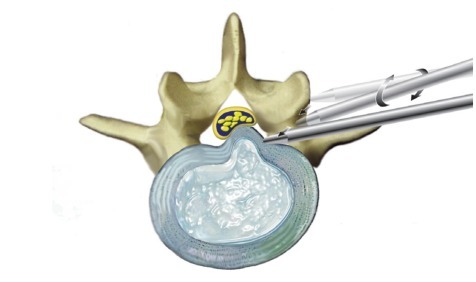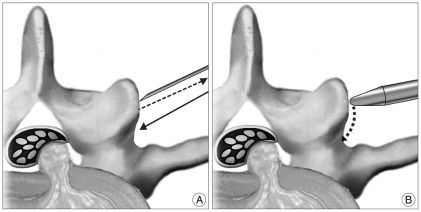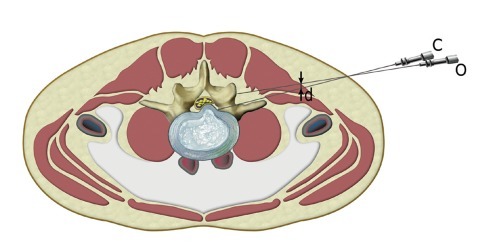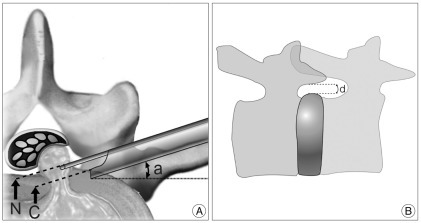J Korean Neurosurg Soc.
2012 Mar;51(3):182-186. 10.3340/jkns.2012.51.3.182.
The Obturator Guiding Technique in Percutaneous Endoscopic Lumbar Discectomy
- Affiliations
-
- 1Department of Neurosurgery & Medical Research Institute, Pusan National University Hospital, Pusan National University School of Medicine, Busan, Korea. spine@pusan.ac.kr
- KMID: 2018197
- DOI: http://doi.org/10.3340/jkns.2012.51.3.182
Abstract
- In conventional percutaneous disc surgery, introducing instruments into disc space starts by inserting a guide needle into the triangular working zone. However, landing the guide needle tip on the annular window is a challenging step in endoscopic discectomy. Surgeons tend to repeat the needling procedure to reach an optimal position on the annular target. Obturator guiding technique is a modification of standard endoscopic lumbar discectomy, in which, obturator is used to access triangular working zone instead of a guide needle. Obturator guiding technique provides more vivid feedback and easy manipulation. This technique decreases the steps of inserting instruments and takes safer route from the peritoneum.
MeSH Terms
Figure
Cited by 2 articles
-
Learning Curve of Percutaneous Endoscopic Lumbar Discectomy Based on the Period (Early vs. Late) and Technique (in-and-out vs. in-and-out-and-in): A Retrospective Comparative Study
Sang-Soak Ahn, Sang-Hyeon Kim, Dong-Won Kim
J Korean Neurosurg Soc. 2015;58(6):539-546. doi: 10.3340/jkns.2015.58.6.539.Foraminoplastic Superior Vertebral Notch Approach with Reamers in Percutaneous Endoscopic Lumbar Discectomy : Technical Note and Clinical Outcome in Limited Indications of Percutaneous Endoscopic Lumbar Discectomy
Chul-Woo Lee, Kang-Jun Yoon, Sang-Soo Ha, Joon-Ki Kang
J Korean Neurosurg Soc. 2016;59(2):172-181. doi: 10.3340/jkns.2016.59.2.172.
Reference
-
1. Ahn Y, Kim JU, Lee BH, Lee SH, Park JD, Hong DH, et al. Postoperative retroperitoneal hematoma following transforaminal percutaneous endoscopic lumbar discectomy. J Neurosurg Spine. 2009; 10:595–602. PMID: 19558294.
Article2. Ahn Y, Lee HY, Lee SH, Lee JH. Dural tears in percutaneous endoscopic lumbar discectomy. Eur Spine J. 2011; 20:58–64. PMID: 20582555.
Article3. Ahn Y, Lee SH, Lee JH, Kim JU, Liu WC. Transforaminal percutaneous endoscopic lumbar discectomy for upper lumbar disc herniation : clinical outcome, prognostic factors, and technical consideration. Acta Neurochir (Wien). 2009; 151:199–206. PMID: 19229467.
Article4. Ahn Y, Lee SH, Park WM, Lee HY, Shin SW, Kang HY. Percutaneous endoscopic lumbar discectomy for recurrent disc herniation : surgical technique, outcome, and prognostic factors of 43 consecutive cases. Spine (Phila Pa 1976). 2004; 29:E326–E332. PMID: 15303041.5. Czervionke LF, Fenton DS. Fenton DS, Czervionke LF, editors. Basic Needle Manipulation Technique. Image-Guided Spine Intervention. 2003. Philadelphia: Saunders;p. 1–7.6. Friedman WA. Percutaneous discectomy : an alternative to chemonucleolysis? Neurosurgery. 1983; 13:542–547. PMID: 6227832.7. Hermantin FU, Peters T, Quartararo L, Kambin P. A prospective, randomized study comparing the results of open discectomy with those of video-assisted arthroscopic microdiscectomy. J Bone Joint Surg Am. 1999; 81:958–965. PMID: 10428127.
Article8. Hijikata SA. A method of percutaneous nuclear extraction. J Toden Hosp. 1975; 5:39–44.9. Kambin P. Percutaneous endoscopic discectomy. J Neurosurg. 1993; 79:968–969. author reply 969-970. PMID: 8246071.10. Kambin P. Kambin P, editor. Posterolateral percutaneous lumbar discectomy and decompression. Arthroscopic Microdiscectomy : Minimal Intervention in Spinal Surgery. 1991. Baltimore: Williams & Wilkins;p. 67–100.11. Kambin P, Brager MD. Percutaneous posterolateral discectomy. Anatomy and mechanism. Clin Orthop Relat Res. 1987; 145–154. PMID: 3652568.12. Kambin P, McCullen G, Parke W, Regan JJ, Schaffer JL, Yuan H. Minimally invasive arthroscopic spinal surgery. Instr Course Lect. 1997; 46:143–161. PMID: 9143957.13. Kambin P, Schaffer JL. Percutaneous lumbar discectomy. Review of 100 patients and current practice. Clin Orthop Relat Res. 1989; 24–34. PMID: 2910608.14. Kambin P, Zhou L. Arthroscopic discectomy of the lumbar spine. Clin Orthop Relat Res. 1997; 49–57. PMID: 9137176.
Article15. Kim HS, Ju CI, Kim SW, Kim JG. Huge psoas muscle hematoma due to lumbar segmental vessel injury following percutaneous endoscopic lumbar discectomy. J Korean Neurosurg Soc. 2009; 45:192–195. PMID: 19352485.
Article16. Kim WJ, Lim ST, Lee SH. Pyogenic psoas abscess and secondary spondylodiscitis as a rare complication of percutaneous endoscopic lumbar discectomy : a case report. Joint Dis Rel Surg. 2005; 16:163–166.17. Kotilainen E, Alanen A, Erkintalo M, Helenius H, Valtonen S. Postoperative hematomas after successful lumbar microdiscectomy or percutaneous nucleotomy : a magnetic resonance imaging study. Surg Neurol. 1994; 41:98–105. PMID: 8115960.
Article18. Lee DY, Lee SH. Learning curve for percutaneous endoscopic lumbar discectomy. Neurol Med Chir (Tokyo). 2008; 48:383–388. discussion 388-389. PMID: 18812679.
Article19. Lee S, Kim SK, Lee SH, Kim WJ, Choi WC, Choi G, et al. Percutaneous endoscopic lumbar discectomy for migrated disc herniation : classification of disc migration and surgical approaches. Eur Spine J. 2007; 16:431–437. PMID: 16972067.
Article20. Lee SH, Kang BU, Ahn Y, Choi G, Choi YG, Ahn KU, et al. Operative failure of percutaneous endoscopic lumbar discectomy : a radiologic analysis of 55 cases. Spine (Phila Pa 1976). 2006; 31:E285–E290. PMID: 16648734.21. Macnab I. Negative disc exploration. An analysis of the causes of nerve-root involvement in sixty-eight patients. J Bone Joint Surg Am. 1971; 53:891–903. PMID: 4326746.22. Mayer HM, Brock M. Percutaneous endoscopic discectomy : surgical technique and preliminary results compared to microsurgical discectomy. J Neurosurg. 1993; 78:216–225. PMID: 8267686.
Article23. Onik G, Helms CA, Ginsburg L, Hoaglund FT, Morris J. Percutaneous lumbar diskectomy using a new aspiration probe. AJR Am J Roentgenol. 1985; 144:1137–1140. PMID: 3873792.
Article24. Ruetten S, Komp M, Godolias G. An extreme lateral access for the surgery of lumbar disc herniations inside the spinal canal using the full-endoscopic uniportal transforaminal approach-technique and prospective results of 463 patients. Spine (Phila Pa 1976). 2005; 30:2570–2578. PMID: 16284597.
Article25. Ruetten S, Komp M, Merk H, Godolias G. Recurrent lumbar disc herniation after conventional discectomy : a prospective, randomized study comparing full-endoscopic interlaminar and transforaminal versus microsurgical revision. J Spinal Disord Tech. 2009; 22:122–129. PMID: 19342934.26. Ruetten S, Komp M, Merk H, Godolias G. Surgical treatment for lumbar lateral recess stenosis with the full-endoscopic interlaminar approach versus conventional microsurgical technique : a prospective, randomized, controlled study. J Neurosurg Spine. 2009; 10:476–485. PMID: 19442011.
Article27. Savitz MH. Same-day microsurgical arthroscopic lateral-approach laser-assisted (SMALL) fluoroscopic discectomy. J Neurosurg. 1994; 80:1039–1045. PMID: 8189259.
Article28. Savitz MH, Doughty H, Burns P. Percutaneous lumbar discectomy with a working endoscope and laser assistance. Neurosurg Focus. 1998; 4:e9. PMID: 17206772.
Article29. Schreiber A, Suezawa Y. Transdiscoscopic percutaneous nucleotomy in disk herniation. Orthop Rev. 1986; 15:35–38. PMID: 3453439.30. Yeung AT, Tsou PM. Posterolateral endoscopic excision for lumbar disc herniation : surgical technique, outcome, and complications in 307 consecutive cases. Spine (Phila Pa 1976). 2002; 27:722–731. PMID: 11923665.31. Yeung AT, Yeung CA. Advances in endoscopic disc and spine surgery : foraminal approach. Surg Technol Int. 2003; 11:255–263. PMID: 12931309.32. Yeung AT, Yeung CA. Kim DH, Fessler RG, Regan JJ, editors. Posterolateral selective endoscopic diskectomy : the YESS Technique. Endoscopic Spine Surgery and Instrumentation : Percutaneous Procedures. 2005. New York: Thieme Medical Pub;p. 201–211.
- Full Text Links
- Actions
-
Cited
- CITED
-
- Close
- Share
- Similar articles
-
- Percutaneous Endoscopic Lumbar Discectomy (PELD)
- Percutaneous Endoscopic Discectomy for Lumbar Disc Herniation
- Transforaminal Endoscopic Surgery: Outside-In Technique
- Huge Psoas Muscle Hematoma due to Lumbar Segmental Vessel Injury Following Percutaneous Endoscopic Lumbar Discectomy
- Clinical Outcomes of Percutaneous Endoscopic Laser Lumbar Discectomy

